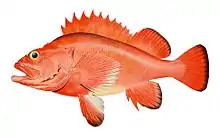Rougheye rockfish
The rougheye rockfish (Sebastes aleutianus) is a rockfish of the genus Sebastes. It is also known as the blackthroat rockfish, rougheye seaperch, blacktip seaperch, longlife seaperch or the blacktip rockfish and grows to a maximum of about 97 cm (38 in) in length,[1] with the IGFA record weight being 14 lb 12 oz (6.7 kg).[2] Similar to many other members of its genus, it is extremely long-lived, and has been known to reach an age of 205 years.[3]
| Rougheye rockfish | |
|---|---|
 | |
| Scientific classification | |
| Domain: | Eukaryota |
| Kingdom: | Animalia |
| Phylum: | Chordata |
| Class: | Actinopterygii |
| Order: | Scorpaeniformes |
| Family: | Scorpaenidae |
| Genus: | Sebastes |
| Species: | S. aleutianus |
| Binomial name | |
| Sebastes aleutianus (D. S. Jordan & Evermann, 1898) | |
| Synonyms[1] | |
| |
Taxonomy
The rougheye rockfish was first formally described as Sebastodes aleutianus in 1898 by the American ichthyologists David Starr Jordan and Barton Warren Evermann with the type locality given as off Karluk on Kodiak Island in the Shelikof Straits in Alaska.[4] This taxon has been considered to be a synonymous with the blackspotted rockfish (S. melanostictus) but that taxon is now accepted as a valid species and both the blackspotted rockfish and the rougheye rockfish are classified within the subgenus Zalopyr.[5] The specific name means of the Aleutian Islands, Kodiak Island used to be considered to be one of the Aleutians.[6]
Description
The rougheye rockfish is so-named because of the ten or so spines found on the lower eyelid. It is pink, tan or brownish with irregular patches of brown of darker color and often a darker patch at the back of the operculum. The posterior part of the lateral line is often pink. An average adult size is about 80 cm (31 in).[7]
Distribution and habitat
Rougheye rockfish are deepwater fish, and exist between 31° and 66° latitude, in the North Pacific, and specifically along the coast of Japan to the Navarin Canyon in the Bering Sea, to the Aleutian Islands, all the way south to San Diego, California.[1] It is found between 150 and 450 m, with larger fish living in deeper water than smaller ones. The temperature at these depths range from −0.3 to 5.0 °C. These fish live near the seabed over boulders and rocks surrounded by soft substrates and in caves and crevices.[7]
Behavior
At some times of year the rougheye rockfish forms schools but during much of the year, larger fish are solitary or roam in small groups. It is among the most long-lived of fish species and individuals are believed to attain an age of over two hundred years.[7] These fish feed on shrimps, crabs, fish, amphipods, and mysids. This species is oviparous and breeds between the months of February and June or sometimes between October and January.[7]
References
- Froese, Rainer; Pauly, Daniel (eds.) (2021). "Sebastes aleutianus" in FishBase. June 2021 version.
- "ScaleMaster Hall of Champions |". 27 October 2010.
- Cailliet, G.M.; Andrews, A.H.; Burton, E.J.; Watters, D.L.; Kline, D.E.; Ferry-Graham, L.A. (2001). "Age determination and validation studies of marine fishes: do deep-dwellers live longer?". Experimental Gerontology. 36 (4–6): 739–764. doi:10.1016/S0531-5565(00)00239-4. PMID 11295512. S2CID 42894988.
- Eschmeyer, William N.; Fricke, Ron & van der Laan, Richard (eds.). "Species in the genus Sebastes". Catalog of Fishes. California Academy of Sciences. Retrieved 1 November 2021.
- James W. Orr and Sharon Hawkins (2008). "Species of the rougheye rockfish complex: resurrection of Sebastes melanostictus (Matsubara, 1934) and a redescription of Sebastes aleutianus (Jordan and Evermann, 1898) (Teleostei: Scorpaeniformes)". Fishery Bulletin. 106 (2): 111–134.
- Christopher Scharpf & Kenneth J. Lazara, eds. (22 May 2021). "Order Perciformes (Part 8): Suborder Scorpaenoidei: Families Sebastidae, Setarchidae and Neosebastidae". The ETYFish Project Fish Name Etymology Database. Christopher Scharpf and Kenneth J. Lazara. Retrieved 1 November 2021.
- "Rougheye rockfish". Alaska Fisheries Science Center. Retrieved 23 December 2013.
![]() Media related to Sebastes aleutianus at Wikimedia Commons
Media related to Sebastes aleutianus at Wikimedia Commons